The 7 Best Upper Body Exercises For Softball Players
Having a strong upper body is essential for softball players. A strong upper body will help you hit farther, throw harder, and be resilient to injury. It is even more important that softball players train their upper bodies intelligently.
You need to consider your shoulders, elbows, and wrists in every movement that you perform. Upper body training is not about getting jacked and pumped up like a bodybuilder. Training the upper body for softball is all about functionality, sport-specific, low risk-to-reward ratio movements, that will directly carry over to throwing and hitting.
To gain strength in the upper half, I think the best implements are barbells, dumbbells, and kettlebells. These implements will engage the most musculature and can be trained and overloaded over time. Never sacrifice your form for weight!
The neurological training benefits are extremely beneficial for all athletes. These compound movements will train the muscles to gain power and strength in the upper body. You are not going to see a lot of bodybuilding or bicep and tricep exercises here. Compound movements train these muscles naturally anyway.
I recommend these movements in the early off-season, fall ball, winter, and in-season training regimen. How heavy, how often, and what exercises you are using are determined by the game schedule and your training readiness.
In this article, I will be going over the 7 best upper body exercises for softball players to help you stay healthy, hit farther, and throw harder!
Upper Body Exercises For Softball
Push-Ups
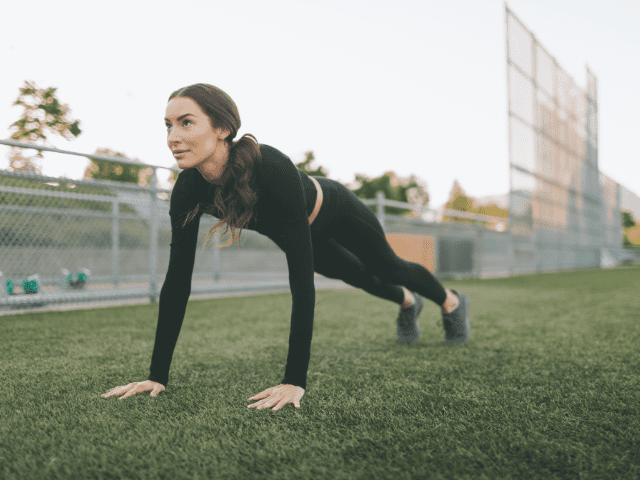
The Push-Up is one of the most important movements a softball player can master.
Relative upper body strength is critical to upper body strength, power, and injury resilience. This is a great horizontal pushing movement that can be progressed, overloaded, and is shoulder-friendly.
I often recommend progressing with the push-up. I progress the push-up with an eccentric phase, focusing on the lowering movement of the push-up. Then the isometric phase, pausing and holding the bottom position of the push-up.
Finally, progressed to the full Push-Up movement.
As you advance, you can slow the eccentric movement down, pause at the bottom, and push yourself back up to the start all in one movement. The Push-Up can also be overloaded with an external weight on your back, called the Weighted Push-Up.
Step-by-Step Instruction
- Starting Position: Begin in a plank position, hands slightly wider than shoulder-width apart, and feet together or slightly apart. Your body should form a straight line from head to heels.
- Descend: Bend your elbows, lowering your body towards the floor while maintaining a straight spine.
- Bottom Position: Get as close to the floor as possible without touching it with your chest.
- Push Up: Extend your elbows, pushing your body back to the starting position.
Coaching Points
Focus on having perfect form, keeping the core engaged, and training the chest, triceps, and shoulder muscles.
Keep the elbows at a 45-degree angle. For maximal chest, shoulder, and rotator cuff engagement, do not let the elbows flare out away from the middle. Also, do not let the elbow hug right next to the torso.
Pull Ups
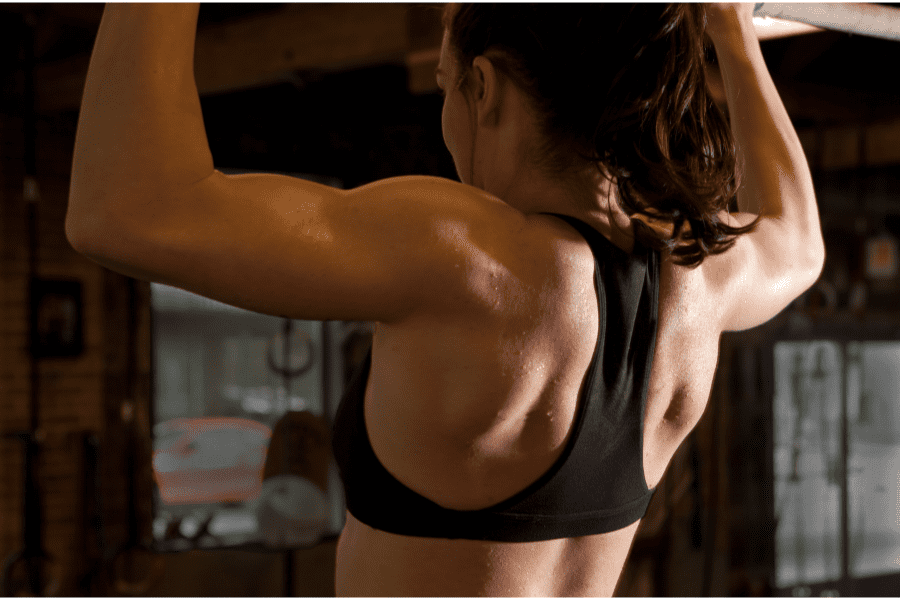
A strong posterior chain is essential for shoulder health and upper body strength. The Pull-Up trains this posterior chain (Lats, upper back, rear delt, rotator cuff) to be strong and resilient. Another added benefit of the pull-up is core and lower back stabilization.
A full range of motion in your pull-ups is critical for success here. I like to progress players into pull-ups.
We initially will start with an eccentric phase, followed by an isometric, and finally a concentric one. I sometimes have lifters use bands to help with their pull-ups initially.
I typically program pull-ups in the early off-season and winter programs. I avoid most heavy overhead movements during fall ball and in-season training regiments due to the high load on the shoulder throwing in-season.
Step-by-Step Instruction
- Approach the pull-up bar and grab the bar with a pronated grip (palms facing away).
- Squeeze the bar and engage the core muscles and do not cross your legs.
- Engage the upper back and pull up until your chin is over the bar.
- Pause for 1 second with your chin over the bar.
- Slowly lower yourself back to the starting position.
Coaching Points
Take your time and master the Pull-Up. The benefits of doing sound Pull-Ups will pay dividends for your shoulder health and the potential to maximize your upper body strength.
If you’re not ready for the Pull-up, don’t worry!
You can start with Inverted Rows and Lat Pulldowns to gain strength. I also recommend straight arm hanging and isometric holds with your chin over the bar. These are great alternatives that will help you in the pull-up progression.
Dumbbell Bench Press
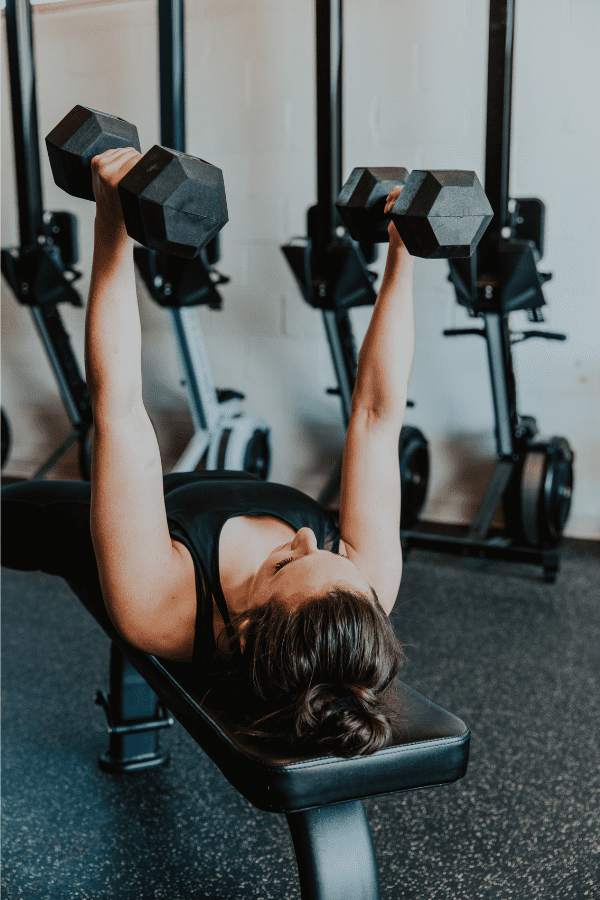
The Dumbbell Bench Press is one of my favorite exercises for softball players. This horizontal press can be progressively overloaded easily and there are lots of variations (Floor press, alternating, single-arm).
I like the dumbbell as a pressing implement more than the barbell for softball players. The dumbbell allows for more natural movement in the shoulder, is more specific to throwing (single arm training), and requires more stabilization.
Step-by-Step Instruction
- Set Up: Choose appropriate dumbbells and lie back on a flat bench, holding them above your chest.
- Grip: Hold the dumbbells with a neutral or pronated grip, palms facing forward.
- Starting Position: Begin with the dumbbells at chest height, elbows bent at about 90 degrees.
- Ascent: Press the dumbbells upward, extending your arms fully above your chest.
- Peak Position: Hold for a brief moment at the top, dumbbells almost touching each other.
- Descending Phase: Lower the dumbbells back to the starting position, controlling the movement.
Coaching Points
This is a very shoulder-friendly pressing movement. Because the implement is a dumbbell, the range of motion is increased, the shear force on the shoulder is decreased, and the shoulder stabilizing muscles are engaged.
You can turn the palms in and keep the elbows tighter to the body to take stress off the shoulders and put more emphasis on the triceps.
Remember to finish your sets with awareness so that you and your training partner/fellow gym members stay safe and injury-free. (aka Be careful when dropping the dumbbells!)
READ MORE –> The Best Core Exercises for Softball Players
One Arm Dumbbell Row
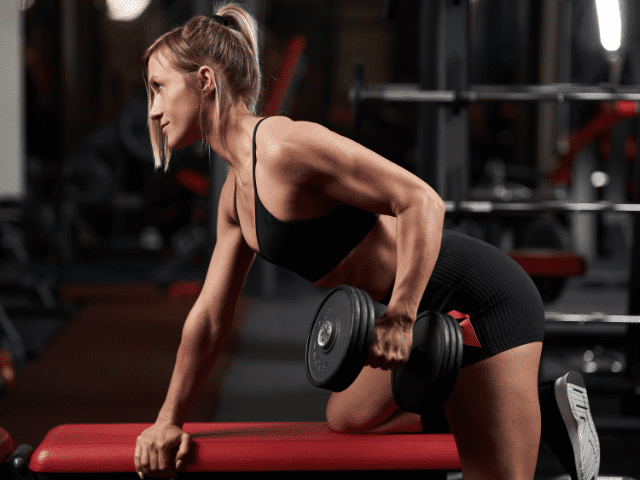
A classic horizontal row that I love for softball players, is the One Arm Dumbbell Row. This is a great rowing variation for single-arm training.
An awesome benefit of this variation is the non-rowing shoulder needs to stabilize as the other performs the row. Because your positioning is perpendicular to the floor, you are also training cross-body tension, engaging that core, and resisting rotation.
We know anti-rotation in the gym will aid in our ability to display rotational power on the field, so this is a great movement to train often!
Step-by-Step Instructions
- Place the dumbbell next to the bench and set yourself up.
- If rowing with the right arm, place the left knee and left hand on the bench. Keep the right foot flat on the ground.
- Make sure the back is flat (neutral) to slightly arched.
- Brace the core and pick the dumbbell up.
- Row the dumbbell up, keeping the elbow close to the body as the dumbbell raises.
- Squeeze the back at the top of the rep and then lower the dumbbell down until the arm is fully extended.
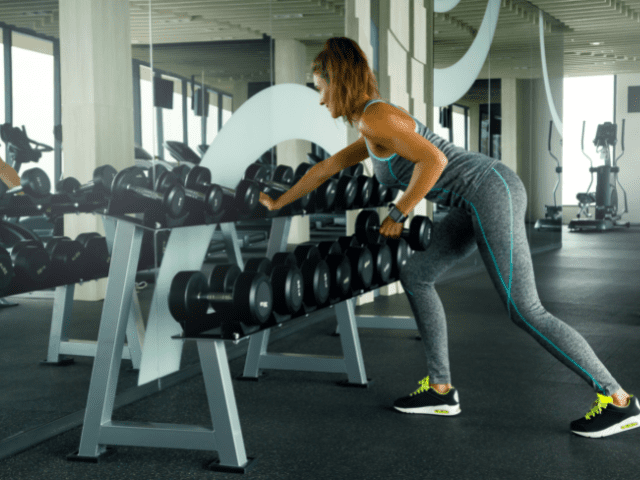
Coaching Points
The most common mistake I see athletes make when doing One Arm Rows is not maintaining a flat back. The back should stay engaged and slightly arched – similar to the starting position of a Deadlift. Do not let the back round as this can cause unnecessary stress on the spine.
Also, do not twist and turn while rowing. You’re not starting a lawn mower. If you need to use your whole body to twist and rock the weight up then the dumbbell is too heavy. Lower the weight and maintain proper form.
Inverted Rows (From Rings)
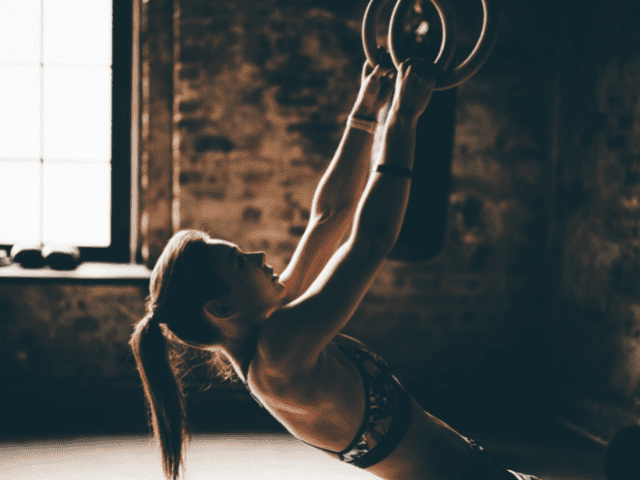
Horizontal rows are one of the key components of a healthy softball player’s strength training routine. One of my favorite rows is the Inverted Row from the rings.
I love Inverted Rows for throwing athletes because the rings reinforce healthy shoulder movement.
Remember, a full range of motion is critical here. Hang all the way down, row your body as one unit, squeeze the shoulder blades, and lock in each rep.
Start with a grip on the rings so that your knuckles are pointing up to the ceiling, as your row, twist your fist so that your thumbs are pointed toward the ceiling at the top of the rep.
Horizontal rows help balance out the shoulder and train those posterior chain muscles to be strong and resilient.
Step-by-Step Instructions
- Set Up: Position a barbell in a squat rack at waist height. Ensure it’s secure.
- Starting Position: Lie under the bar, grasping it with an overhand grip, hands slightly wider than shoulder-width.
- Body Alignment: Ensure your body forms a straight line from your heels to your head. Engage your core and glutes.
- Pull: Pull your chest towards the bar, squeezing your shoulder blades together.
- Peak Position: Get as close to the bar as possible, maintaining your body alignment.
- Lower: Control the descent, extending your arms and returning to the starting position.
Coaching Points
You should think of the Inverted Row like a reverse bench press. Keep your head back, chest out and pull your chest directly to the bar. Pull the shoulder blades down and back at the top of the rep and squeeze the back.
The second mistake I see all too often is tired athletes who start to look like they’re doing the worm. They start rocking and rolling their entire body to try to get their chest up to the bar. Don’t do this! Maintain a rigid body posture and continue pulling yourself as high as you can each rep.
Half Kneeling Single-Arm Dumbbell Press
One of my favorite shoulder-friendly pressing movements, the Half-Kneeling Single-Srm Dumbbell Press is a great movement for softball players to gain strength in the overhead pressing pattern.
This is a great exercise for softball players because overhead strength and stability are critical for throwing hard and being resilient to injury.
I also love dumbbells as pressing implements because they force the athlete to train with a single arm (Sport specific) and stabilize each movement.
Step-by-Step Instruction
- Starting Position: Begin in a half-kneeling position with one knee down and the other foot planted in front. Ensure the forward foot is in line with the back knee.
- Hold the Weight: With the arm on the same side as the down knee, hold a dumbbell at shoulder height.
- Stabilize: Engage your core and make sure your hips are square to avoid leaning to one side.
- Press: Extend your arm, pressing the dumbbell overhead. Keep your wrist stable and shoulder away from the ear.
- Top Position: Ensure your arm is fully extended overhead, without arching your back.
- Lower: Control the descent, bringing the dumbbell back to shoulder height.
Coaching Points
I am a huge fan of the tall-kneeling position. It challenges the lifter to balance, stay tall and rigid, and disallows the legs from cheating in helping the press.
This is a great movement for novice lifters that need a progression into overhead pressing. After 2-3 weeks of training, 2 dumbbell, standing, landmine, and barbell options will fall in line for this progression.
Bent-Over Dumbbell Row
A lift that I think helps train the whole body, the Bent-Over Dumbbell Row is a great horizontal rowing exercise.
This is a great rowing variation that I think softball players can benefit from. It trains the horizontal rowing pattern, trains the posterior chain, is joint-friendly, and can be trained heavier over time.
Step-by-Step Instruction
- Stand with your dumbells at your sides on the ground.
- Hinge at the waist and bend the knee until you can grab the dumbbells.
- Always keep a flat back, a neutral spine, and keep your eyes focused slightly down about 1 foot in front of you.
- Take a deep breath, brace the abdomen, and pull the dumbbells in until they are in line with your torso.
- Pause for about 1 second. Squeeze the shoulder blades and lock in the rep.
- Slowly return the dumbbells back to the starting position (dumbbells at about the knee).
Coaching Points
The setup here is very similar to the Deadlift. With that in mind, always remember to keep a nice neutral spine.
Another common mistake I have seen is lifters go too heavy and therefore need to “hitch or yank” into a lock-in position. Never sacrifice your form for more weight.
Final Thoughts
Upper body training is critical for softball players.
Getting strong with basic movements like push-ups and pull-ups will only benefit your health and performance. Utilizing barbells, dumbbells, and kettlebells to overload your upper body work is great as well.
Balancing pushing and pulling movements is important. In general, for every 1 push repetition programmed, I would aim to have 3 pulling repetitions programmed.
Remember why you are training. Everything you do should have some type of carry-over to your sport. Training with a specific purpose will always help you stay motivated and train hard consistently over time.
Focus on proper form, progressive overload, and continue to work hard on the field and you will see your results pay off!
If you found this article helpful, make sure to check out my favorite lower-body exercises for softball as well!

